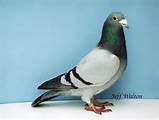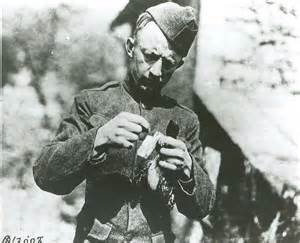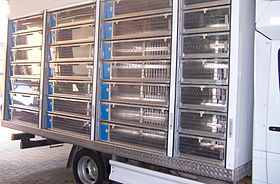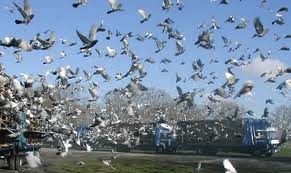Encyclopedia Dubuque
"Encyclopedia Dubuque is the online authority for all things Dubuque, written by the people who know the city best.”
Marshall Cohen—researcher and producer, CNN
Affiliated with the Local History Network of the State Historical Society of Iowa, and the Iowa Museum Association.
PIGEON RACING
PIGEON RACING. Racing pigeons are descended from the Rock Dove. The earliest reference to the use of messenger pigeons comes from Ramses III (c1200 BC) when they were used to carry news between cities regarding the flood state of the Nile. (1)
The Romans used pigeons to convey messages throughout the empire, for example Olympic games results for betting syndicates, and ships warning their home port of their arrival. Carrier pigeons were held in high regard in the Arab world where they were called “The Kings Angels.” Pigeons were brought back to Europe by the Crusaders. (2) In the 1800s France had an official pigeon postal service. This was expanded between capitals. A postal service by carrier pigeon between London and Paris was advertised in 1870. (3)
Pigeon racing became a sport of the masses in the early 1900s. Pigeons were used as message carriers by armies on both sides during WORLD WAR I and WORLD WAR II. (4)
In many respects the sport has changed dramatically from the early days. In some areas, there has been little change. Timing clocks, designed at the turn of the century, are still in use in many clubs, while other members use modern, electronic and Quartz regulated timers. In England, rules evolved so that "the pensioner with a 1920s Toulet clock can compete on equal terms with the modern fancier having the latest in computer based technology." (5)
The first pigeon races in England were conducted over relatively short distances using motor transportation. Long distance racing was made possible by use of the railway system. There have been occasions where the use of air transport has been suggested but, at the present time, the cost is too great. (6)
Pigeon racers may enter their birds up to twenty-five times a year on flights ranging from 150 to 500 miles. In races, the birds fly at about 50 miles per hour. (7)
Training begins as soon as the young birds can fly. Short flights are made around the yard. The distance gradually increases to a mile, then two miles. Eventually 50-mile practice flights may result in the pigeons beating the trainer home. (8) The breeding, feeding, and careful checking of feathers and wings has resulted in racing pigeons having hearts nearly twice the size of other pigeons. It flies at an average speed of 40-60 miles per hour with an uncanny ability to find its way back to its loft from wherever it is released. (9)
When ready, the birds are entered in races against other competitors. All the pigeons in a race are transported in a special trailer to a location roughly an equal distance for all racers involved. Each bird is banded with an identification number on one leg and a radio module on the other. The bands are used to record flight times in races and to help racers recover lost birds, some of which can cost up to $3,000. (10)
Racing pigeons make hundreds of choices during a race. Running into a storm front, they can take a bad route around it or get off course flying around a large tower antenna. Directions can be confused in a crosswind along an unfamiliar hillside. Sometimes the pigeons simply fly off course or follow another racers' birds home. That can throw the birds miles off course. Hawks capable of catching a pigeon in flight pose the biggest threat. (11)
The longer the birds stay out, the hungrier they get. From experience, the birds know that after they fly, their lofts are stocked with plenty of high-protein bird feed, peanuts and water. (12)
Racing pigeons continues as a thriving sport in Europe, Asia and the Middle East but is decreasing in the United States. (13) To encourage new people into the sport the American Pigeon Racing Union sponsors a "Help-A-Beginner Program." The program is made up of volunteers who want to help beginners (2nd year flyers) with advice & possibly some birds. Program is meant to offer the novice the opportunity to ask questions of feeding, training, breeding, and medication. (14)
Qualification requirements include:
- The beginner must belong to an AU affiliated club & be an AU member in good standing.
- The beginner must have flown one, and only one, old or young bird racing season.
- The beginner must maintain a loft in a clean and healthy fashion that is not detrimental to the general image of the racing pigeon sport.
In Dubuque, Chad Blocklinger is an prize-winning pigeon racer. (15)
NATIONAL ACE PIGEON SUMMARY REPORT (Long Distance) (16) AU National Database---2014 Old Bird Season
Printed on February 13, 2015 Qualified birds from Iowa
POS AVE UNIRATE: 1 8.306%
NAME: Chad Blocklinger
RACING PIGEON: 0095 AU 13 ER
CLR SEX: BC C
QUALIFYING RACE MILES: 413, 459, 526
---
Source:
1. "Pigeon History," Royal Pigeon Racing Association. Online: http://www.rpra.org/pigeon-history/
2. Ibid.
3. Ibid.
4. Ibid.
5. "About RPRA," Royal Pigeon Racing Association. Online: http://www.rpra.org/pigeon-history/
6. Johnson, Neil. "Pigeon Racers Turn Birds Loose, Sweat the Return. The Janesville Gazette Posted: 08/24/2013. Online: http://www.twincities.com/news/ci_23932385/pigeon-racers-turn-birds-loose-sweat-return
7. Ibid.
8. Ibid.
9. "Pigeon Fanatics Breed for Speed," Telegraph Herald, December 11, 2005, p. C7
10. Ibid.
11. Ibid.
12. Ibid.
13. "Pigeon Fanatics Breed for Speed"
14. "Help-A-Beginner Program," American Racing Pigeon Union. Online: http://www.pigeon.org/beginnerscorner.htm
15. Dr. Darryl Mozena. Interview. February 13, 2015
16. AU National Database Homepage. Online: http://www.pigeon-ndb.com/ndb.php





